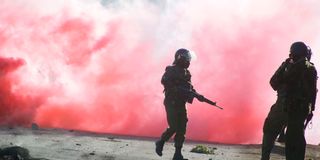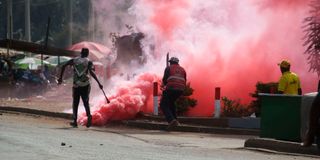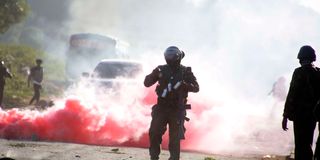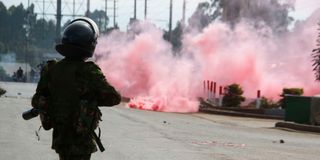Premium
Explainer: What, exactly, is the reddish-orange tear gas police used on protesters?

A policeman lobs a tear gas canister to disperse anti-government protesters in Karatina town in Nyeri County on July 2, 2024.
Of the many shades and colours that painted Nairobi's Central Business District during last week's anti-government protests, orange-red caught the attention of many Kenyans, some literally.
Both online and offline, the colour became the talk of the town as police used tear gas and water to quell the protests.
“Hey guys in town, kindly confirm something. I am told that pink tear gas called Agent Orange is still stinking till now? Is this true?” the Kenyan Vigilante tweeted on June 17, 2023.

A policeman lobs a tear gas canister to disperse anti-government protesters in Karatina town in Nyeri County on July 2, 2024.
From here, speculation and fake news followed, amid fears that the regime was unleashing weapons of possible mass destruction on citizens.
So what exactly was this orange-red substance? According to experts, it was tear gas of a different colour.
According to Enock Makanga, a security expert who has run a private security company for the past two decades, the "strange" tear gas is Oleoresin Capsicum (OC) spray.
This tear gas, he says, is often derived from capsaicin -- an active ingredient in chilli peppers.
This extract from the pepper is a chemical irritant to mammals, including humans, and causes a burning sensation in any tissue it comes into contact with.
This particular tear gas is usually described as high potency, with immediate effects lasting between 30 and 60 minutes.
“It is a strong type of tear gas. It causes intense burning and pain in the eyes, nose, mouth, and skin. It leads to temporary blindness, difficulty breathing, and a strong burning sensation,” Makanga said.

A policeman lobs a tear gas canister to disperse anti-government protesters in Karatina town in Nyeri County on July 2, 2024.
His views were echoed by several motorcyclists from Moi Avenue who felt the effects of the tear gas.
They all said that unlike the usual whitish tear gas, the orange-reddish one seemed so concentrated that they were forced to move to another street for almost half an hour before the sting faded.
“This is not your usual tear gas. I have shed a lot of tears. My eyes and nose are on fire. This red one is hot. The GenZs said they want another flavour, but this one is on another level,” said Cabanas Musau, a rider.
Oleoresin capsicum (OC) spray is most commonly used in personal self-defence sprays by law enforcement.
The other tear gas, the most common whitish-grey one that the Kenyan protesters said they were used to, is 2-Chlorobenzalmalononitrile (CS gas).
Usually dispersed as a white or grey smoke, it is widely used for riot control and crowd dispersal.
“It causes severe eye irritation, tearing, burning sensations and temporary blindness. It also irritates the skin and respiratory system, leading to coughing, choking and a sensation of suffocation,” Makanga said.
This tear gas is usually very effective as it has a rapid onset of symptoms, but these effects often subside within minutes.
During the recent demonstrations, protesters were able to regroup within minutes of being dispersed by this particular type of tear gas -- a testament to how quickly its effects wear off.
The other tear gas closely related to CS gas is CR gas (dibenzoxazepine). However, experts say CR gas is more potent and is often dispersed as a white or yellowish smoke.
It is less commonly used, but is sometimes used in some riot control situations. It is usually very effective when used in low concentrations and causes prolonged discomfort.
The fourth type of tear gas used is CN gas (chloroacetophenone), which usually emits a white or pale yellow smoke. It is commonly used in personal self-defence sprays.

A policeman lobs a tear gas canister to disperse anti-government protesters in Karatina town in Nyeri County on July 2, 2024.
It is less potent than CS gas, but can still cause significant discomfort, with effects lasting longer than CS, sometimes several hours.
“This is majorly because it is usually used on close proximity with the target. Primarily, it affects the eyes, causing tearing, burning and pain. It can also cause skin irritation and respiratory distress,” Makanga said.
In a report entitled Lethal in Disguise 2, published by the International Network of Civil Liberties Organisations and Physicians for Human Rights in 2023, the use of chemical irritants, i.e. tear gas, should be reviewed and, if possible, eliminated.
The same chemicals, the report says, are often diluted in water cannons and the same content poured on protesters.
“This is a growing problem with reports of skin irritation and pain. There has also been growing use of other composite weapons, such as pepper balls or water cannons laced with chemical irritants, which complicate the identification of weapons, as well as the treatment of injuries,” the report stated.
George Musamali, a security expert and former police officer, said the orange-reddish tear gas seen last week is a very potent crowd control weapon.
“I was very shocked to see that orange tear gas. It was never used during my time in the Service (police). I was surprised that we even have it in Kenya,” he said.
Musamali also clarified that had it been Agent Orange, serious cases of respiratory problems, skin irritations and eye problems would have already caused a problem for the country's health system.
“Agent Orange reacted violently with the bodies of people who came into contact with it and slowed down people’s nervous system and other internal body organs as well as death,” he said.
Agent Orange is a chemical that came to prominence during the Vietnam War and was used as a tactical herbicide by the US military to defoliate trees, destroy enemy crops and disrupt food supplies. It was banned after the Vietnam War.
The chemical was banned because it was found to have a negative impact on the quality of life of citizens and military personnel alike, causing various illnesses and even death, Musamali said.
The US National Library of Medicine estimates that some 11 million gallons of Agent Orange were sprayed by the US Air Force between 1962 and 1971 in a military project called Operation Ranch Hand.
The Red Cross estimates that three million Vietnamese have been affected by dioxin, a highly toxic and persistent organic pollutant found in Agent Orange and linked to cancer, diabetes, birth defects and other disabilities.
Musamali said the appearance of the orange-reddish tear gas, which is rarely used, was worrying and police should be asked to explain what justified its use.
The other type of orange gas commonly used for crowd control is the smoke grenade, the security expert explained.
However, this particular gas, unlike the OC gas, is harmless and you can walk through it without feeling any irritation.
Its main function is to reduce visibility.
“This is usually mostly used during active combat or when crowds are out of control. It usually enables the security officers to camouflage themselves so that they cannot be seen by the enemy,” he said.





